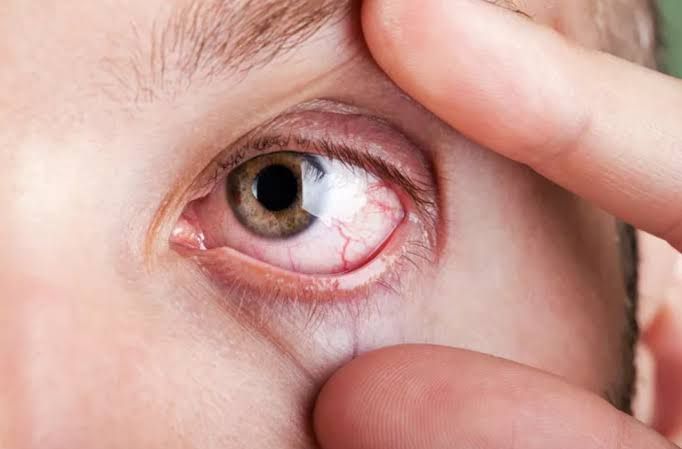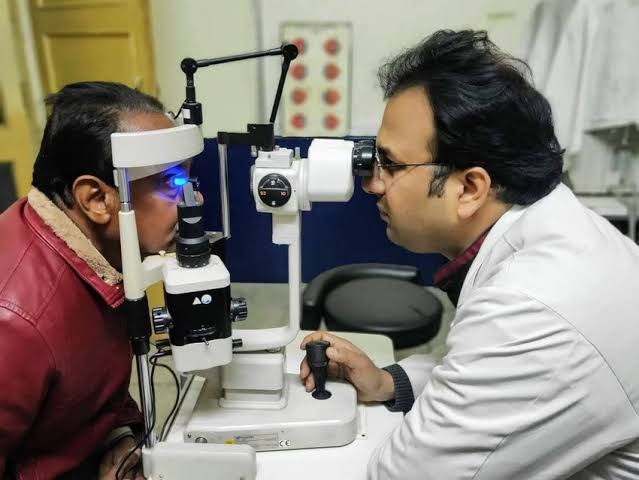
Xerophthalmia, a term derived from the Greek words “xeros” (dry) and “ophthalmos” (eye), refers to a spectrum of ocular abnormalities caused by Vitamin A deficiency. This preventable and treatable condition can range from mild night blindness to severe corneal ulceration and blindness, significantly impacting public health, particularly in developing nations.
Defining Xerophthalmia and its Contributing Factors
At its core, xerophthalmia is the ocular manifestation of Vitamin A deficiency (VAD). Vitamin A, a fat-soluble vitamin, plays a crucial role in various physiological processes, including vision, immune function, and cell growth and differentiation. In the context of vision, Vitamin A is a vital component of rhodopsin, a light-sensitive pigment found in the rod cells of the retina. Rhodopsin is essential for dim-light vision, also known as scotopic vision. When Vitamin A is deficient, the production of rhodopsin is impaired, leading to a reduced ability to see in low light conditions.
Several factors contribute to the development of xerophthalmia:
- Inadequate Dietary Intake: This is the most prevalent cause. Vitamin A is found in two main forms: preformed Vitamin A (retinol) in animal products like liver, eggs, and dairy, and provitamin A carotenoids (like beta-carotene) in plant-based foods such as carrots, sweet potatoes, and leafy green vegetables. In many regions, diets are heavily reliant on staple foods that are poor in both forms of Vitamin A, leading to widespread deficiency.
- Malabsorption Syndromes: Conditions that impair the absorption of fats also hinder the absorption of fat-soluble vitamins, including Vitamin A. These include:
- Celiac disease: An autoimmune disorder affecting the small intestine.
- Cystic fibrosis: A genetic disorder affecting mucus-producing glands.
- Crohn’s disease and ulcerative colitis: Inflammatory bowel diseases.
- Pancreatic insufficiency: Conditions where the pancreas does not produce enough digestive enzymes.
- Biliary atresia: A condition in infants where the bile ducts are blocked or absent.
- Increased Requirements: Certain physiological states increase the body’s demand for Vitamin A, potentially leading to deficiency if intake is not adjusted accordingly:
- Pregnancy and lactation: Increased maternal needs to support fetal growth and milk production.
- Rapid growth periods: Infancy and childhood require higher Vitamin A for proper development.
- Infections: Certain infections, particularly measles and diarrheal diseases, can deplete Vitamin A stores and increase the body’s requirements.
- Liver Disease: The liver is the primary storage site for Vitamin A. Chronic liver diseases can impair the storage and release of Vitamin A, contributing to deficiency.
- Chronic Alcoholism: Excessive alcohol consumption can interfere with Vitamin A absorption and metabolism.
The World Health Organization (WHO) Classification of Xerophthalmia
The WHO has established a comprehensive classification system for xerophthalmia, enabling standardized diagnosis and assessment of severity. This classification is based on clinical signs observed in the eye and is crucial for epidemiological surveys and guiding public health interventions. The stages are typically categorized as follows:
- XN (Night Blindness): This is the earliest and mildest subjective symptom of xerophthalmia. Individuals experience difficulty seeing in dim light or at dusk. While not a visible sign, it is a crucial indicator of early VAD.
- X1A (Conjunctival Xerosis): This stage is characterized by drying of the conjunctiva, the clear membrane covering the white part of the eye. The conjunctiva loses its luster and becomes dull, wrinkled, and opaque.
- X1B (Bitot’s Spots): These are triangular, foamy or cheesy-looking patches that appear on the conjunctiva, typically on the temporal side (near the nose) of the cornea. Bitot’s spots are composed of keratinized epithelial cells and are considered a classic sign of conjunctival xerosis.
- X2 (Corneal Xerosis): This stage involves drying of the cornea, the transparent front part of the eye. The cornea loses its smooth, moist surface and appears hazy or cloudy. This significantly impairs vision.
- X3A (Corneal Ulceration/Necrosis): In this advanced stage, the cornea begins to break down, forming ulcers or areas of tissue death (necrosis). This is a critical stage that can lead to permanent vision loss.
- X3B (Corneal Scarring): Following ulceration and healing, the cornea may develop scars, which can obstruct vision depending on their location and size.
- XS (Corneal Scarring): This notation is used to denote the presence of corneal scars, regardless of the preceding stage of ulceration.
- XF (Fundus Xerophthalmia): This refers to changes in the retina, specifically the presence of small, discrete, yellowish-white spots or granular deposits in the peripheral retina. These changes are typically seen in more severe or chronic cases.
It is important to note that the progression through these stages is not always linear, and individuals may present with different combinations of signs.
Clinical Features and Differential Diagnosis
The clinical presentation of xerophthalmia varies greatly depending on the stage and severity of Vitamin A deficiency.
1. Clinical Features:
- Early Stages (XN, X1A):
- Difficulty seeing in dim light (night blindness).
- Dry, gritty sensation in the eyes.
- Itching and burning of the eyes.
- Increased sensitivity to light (photophobia).
- Conjunctiva appears dull, opaque, and wrinkled.
- Presence of Bitot’s spots.
- Advanced Stages (X2, X3A, X3B, XS):
- Blurred vision.
- Corneal ulcer, appearing as a defect on the cornea with surrounding inflammation.
- Corneal perforation: A complete breakdown of the cornea, leading to leakage of intraocular fluid.
- Iris prolapse: The iris protruding through a corneal perforation.
- Endophthalmitis: Infection within the eyeball, a severe complication leading to vision loss.
- Corneal scarring, which can range from mild opacities to dense leukomas (white scars) that completely obscure vision.
- Phthisis bulbi: A shrunken, non-functional eyeball, the end-stage of severe ocular damage.
2. Differential Diagnosis:
It is essential to differentiate xerophthalmia from other conditions that can cause similar ocular symptoms. Key differential diagnoses include:
- Other causes of night blindness:
- Retinitis pigmentosa: A group of inherited retinal disorders.
- Congenital stationary night blindness: An inherited condition present from birth.
- Diabetic retinopathy: Damage to retinal blood vessels due to diabetes.
- Other causes of dry eye:
- Sjögren’s syndrome: An autoimmune disorder causing dry eyes and dry mouth.
- Allergic conjunctivitis: Inflammation of the conjunctiva due to allergens.
- Blepharitis: Inflammation of the eyelids.
- Contact lens-related dry eye.
- Environmental factors: Dry air, wind, smoke.
- Other causes of corneal ulceration:
- Bacterial keratitis: Corneal infection caused by bacteria.
- Fungal keratitis: Corneal infection caused by fungi.
- Herpetic keratitis: Corneal infection caused by the herpes simplex virus.
- Traumatic corneal abrasions or lacerations.
- Nutritional deficiencies other than Vitamin A: For example, severe protein deficiency can also lead to corneal changes.
A thorough clinical examination, including a detailed history of diet, medical conditions, and exposure to environmental factors, along with a comprehensive ophthalmic assessment, is crucial for accurate diagnosis.
Age-Related Factors of Xerophthalmia
Xerophthalmia disproportionately affects certain age groups:
- Infants and Young Children (6 months to 6 years): This age group is the most vulnerable to xerophthalmia. Infants and young children have high physiological requirements for Vitamin A due to rapid growth and development. Furthermore, their diets may be limited in Vitamin A-rich foods, especially if they are weaned onto nutrient-poor complementary foods. Infections like measles and diarrhea are also more common in this age group, further depleting their Vitamin A stores. Consequently, xerophthalmia is a leading cause of preventable childhood blindness globally.
- Pregnant and Lactating Women: These women have increased nutritional needs to support fetal development and milk production. Inadequate Vitamin A intake during pregnancy can lead to VAD in both the mother and the developing fetus, while during lactation, it can affect the vitamin content of breast milk, impacting the infant’s nutritional status.
- Elderly Individuals: While less commonly affected than young children, the elderly can also be at risk, particularly if they have underlying health conditions that affect nutrient absorption or if their dietary intake is compromised due to poor appetite, dental problems, or limited access to nutritious food.
Management and Prevention of Xerophthalmia
Effective management of xerophthalmia involves both treating existing deficiency and implementing robust prevention strategies.
Management:
The management of xerophthalmia is based on the severity of the condition:
- Vitamin A Supplementation: This is the cornerstone of treatment. High-dose Vitamin A is administered orally. The dosage varies depending on the age and severity of xerophthalmia. For example, infants and young children with active xerophthalmia often receive multiple doses over a period to replenish their stores.
- Treatment of Underlying Causes: If malabsorption syndromes or other contributing medical conditions are identified, these need to be managed appropriately to improve Vitamin A status.
- Lubrication and Supportive Care: For cases with corneal xerosis and ulceration, artificial tears and lubricating ointments are used to protect the ocular surface and prevent further dehydration.
- Antibiotics: If bacterial infection is suspected or confirmed in the presence of corneal ulceration, topical or systemic antibiotics are prescribed to prevent or treat infection.
- Surgical Intervention: In severe cases of corneal perforation, surgical management such as corneal grafting (keratoplasty) may be considered to restore vision, although success rates can be variable depending on the extent of damage.
Prevention:
Preventing xerophthalmia is a public health priority and involves a multi-pronged approach:
- Vitamin A Supplementation Programs: Regular high-dose Vitamin A supplementation for children in vulnerable age groups (typically every 4-6 months) is a highly effective strategy to prevent deficiency and xerophthalmia.
- Dietary Diversification and Education: Promoting diets rich in Vitamin A, through awareness campaigns and education on the importance of consuming fruits, vegetables, and animal products, is crucial. This includes educating mothers on appropriate infant feeding practices and the nutritional value of local foods.
- Food Fortification: Fortifying staple foods like flour, sugar, or oil with Vitamin A can significantly improve the intake of this essential nutrient at a population level. This is a sustainable approach to addressing widespread deficiency.
- Addressing Malnutrition and Infections: Improving overall child health through immunization programs, prevention and management of diarrheal diseases, and combating childhood malnutrition are vital to reducing the burden of xerophthalmia.
- Post-Exposure Prophylaxis Following Measles: Children who have had measles are at increased risk of VAD. They should receive Vitamin A supplementation as part of their post-measles care.
- Prenatal and Postnatal Care: Ensuring adequate Vitamin A intake for pregnant and lactating women is essential for maternal and child health.
In conclusion, xerophthalmia is a serious, yet largely preventable, consequence of Vitamin A deficiency. By understanding its causes, recognizing its varied clinical presentations, and implementing comprehensive management and prevention strategies, public health initiatives can significantly reduce the incidence of this debilitating eye condition and safeguard vision for millions worldwide. Continued efforts in education, supplementation, food fortification, and healthcare access are paramount in the global fight against xerophthalmia.







